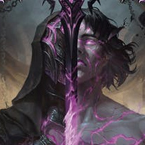Aside from the Fable, Outsiders is fully spoiled at this point, and there is no shortage of interesting cards in the set. Ranger got a new hero in Riptide, along with many welcome upgrades and a new equipment slot. Katsu gained some additional flexibility and a powerful new combo line that culminates in the game-defining Dishonor. Meanwhile, Assassin got its second adult hero in Uzuri, Switchblade, and seeing her instantly sent me down the brewing rabbit hole.
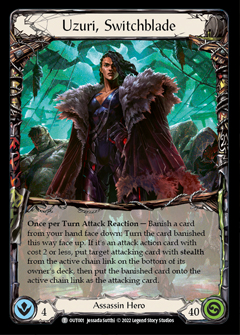
Unequitable Exchange
Uzuri's ability is relatively simple. When you're attacking with a card that has stealth, once per turn she will let you upgrade it to another attack action in your hand that costs 2 or less. An innocuous looking blue Infect could suddenly be a Command Conquer aimed at your face - and by the time you know the replacement card is CnC, it's already too late to play additional defense reactions.
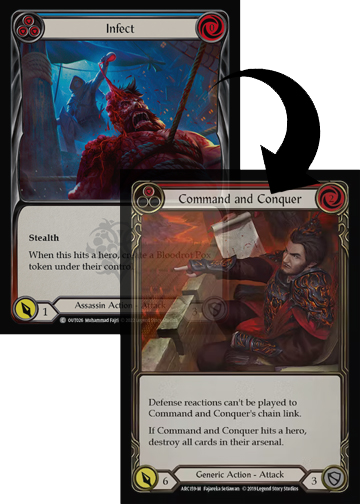
This has interesting ramifications for Uzuri's resource economy. All eight stealth attack actions in the set cost zero resources to play, so you can use Uzuri's ability off *any* two-card hand (as long as one card is a stealth attack). The upside to this is, if you're faced with a quad red hand, you can still block with two cards and cheat in a two-cost attack on your turn without needing any additional resources. However, when you're not resource starved, if you use two cards to put a Command and Conquer into play attacking, you are, in theory, losing out on a resource as you could have just played the CnC by pitching a blue card. Assuming an average pitch curve for the deck, you're effectively paying one resource for the ability to switch out your attack at reaction speed. Similar to Dorinthea, Uzuri asks opponents the question, "What do you think I have?" and forces them to make decisions with incomplete information.
Uzuri's ability also has another strong yet subtle ability: avoiding play requirements and triggers.
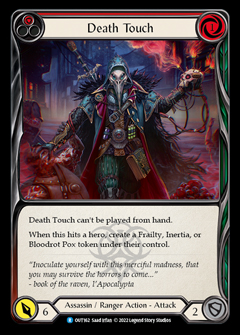
Death Touch normally cannot be played from hand, but fortunately for us, Uzuri's ability doesn't technically play the card. Instead, it enters play already attacking, which exempts it from its own restriction. Similarly, Gore Belching would normally receive a debuff when played, but when we sneak it into play via Uzuri's ability, we have already passed the step where its play ability would trigger, so we get the full 7 power for our trouble.
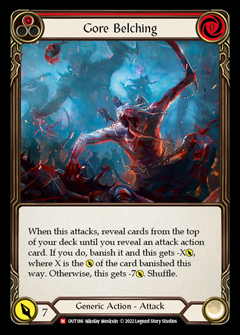
The Rules of the Sneak
The suite of available stealth cards is quite interesting, and how you evaluate them could vary greatly depending on how you're trying to build your deck. While some of the attacks have abilities that hinder opponents’ ability to defend, others have potent on-hit effects.
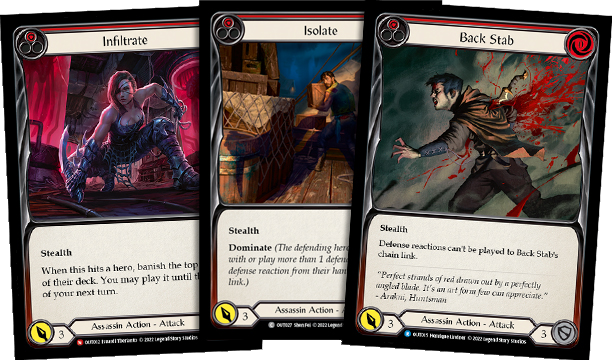
Isolate is to stealth cards what Take Flight is to charge cards. Whether you're leaning heavily into the stealth attack reactions or just swapping it out for larger attacks, dominate is an amazing keyword for a stealth attack. Infiltrate is a majestic for good reason, as it threatens both card advantage for us but also a lost card from deck for the opposing hero (imagine hitting Bravo with his own Pummel). Back Stab is a card that entirely depends on your intended build. If you are leaning heavily into the Spike with Bloodrot/Inertia/Frailty attack reactions, then this card is great. If your opponent over blocks it, you just arsenal and move on having gained value. If they don't over block, you can safely resolve your Spikes and hand your opponent a pile of tokens.
Infect, Sedate, and Wither each give the opponent their corresponding token on hit. Naturally that means these attacks all want to hit, which is a little at odds with Uzuri's ability pulling them out of combat. Infect threatens to be 5 damage, which means it's the highest damage potential stealth card, but depending on how the format shakes out it could be better or worse than Sedate (Inertia tokens are no joke).
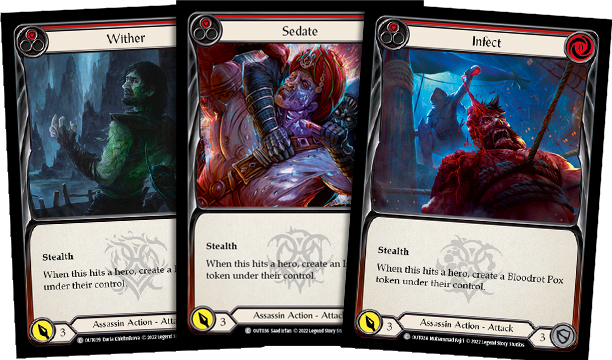
Wither is fine, but has the narrowest application. If we end up in a format dominated by Ninjas, Assassins, and Rangers, Frailty looks much better, but I think it's effect will mostly be relegated to limited.
Since many of our stealth cards will tend to be switched out, the rate on them matters marginally less than it normally would, which means stealth cards are great candidates for filling out your suite of blue 3-blocks.
Ambush!
So what are we switching in for these stealth attacks?
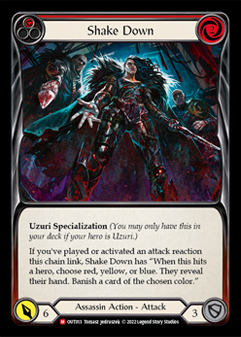
Shake Down is probably the best card to sneak into play via Uzuri's ability (certainly fitting for her specialization). Hand disruption effects are very good in Flesh and Blood, and while Shake Down can potentially miss, it should hit most of the time if you choose a color wisely. Death Touch is a card that is above rate for its cost in every color, but Uzuri's ability takes it a step further by circumventing the "can't be played from hand" requirement. Spreading Plague is Assassin's Twinning Blade; it punishes opponents for blocking too heavily on our attacks.
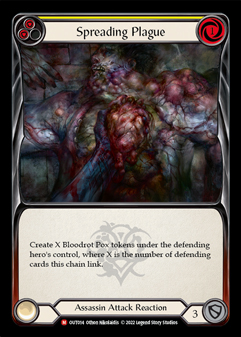
Cycling back to Dynasty, we can add in more hand disruption and threatening cards in arsenal with Surgical Extraction and Leave No Witnesses. These are the best two cards in Arakni, and they might be even better here. Notably, they are likely the lone silver generation the deck will have.
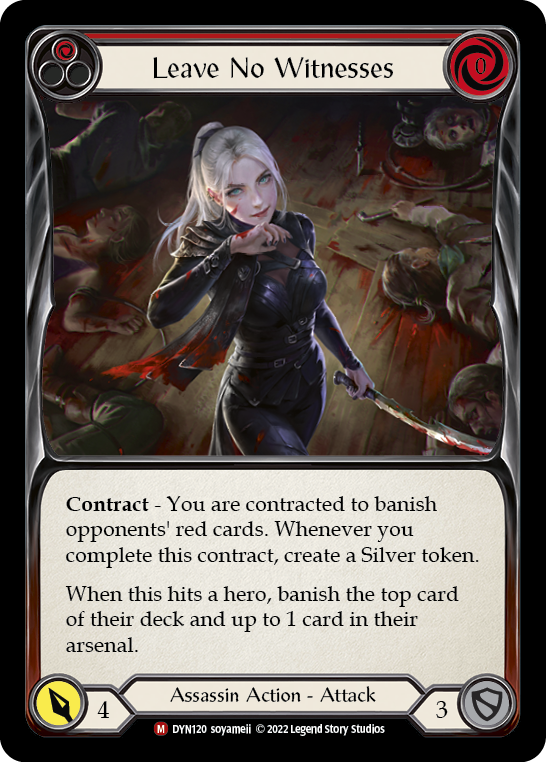
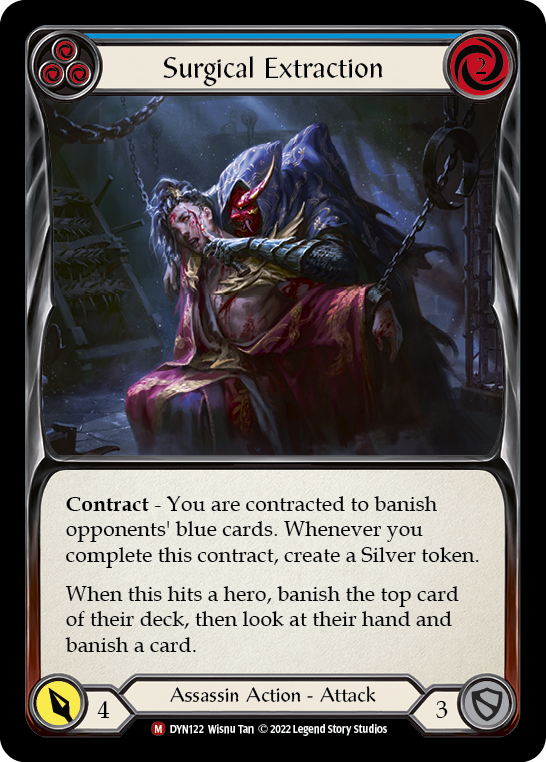
Since we're "giving up" a card to use Uzuri's reaction, the non-majestic 4 power contract attacks are too below rate. Even the 5 power attacks (Rob the Rich, Annihilate the Armed, and Nix the Nimble) are below rate for CC, but if you're close to guaranteed a silver for your trouble, they come closest to cutting it.
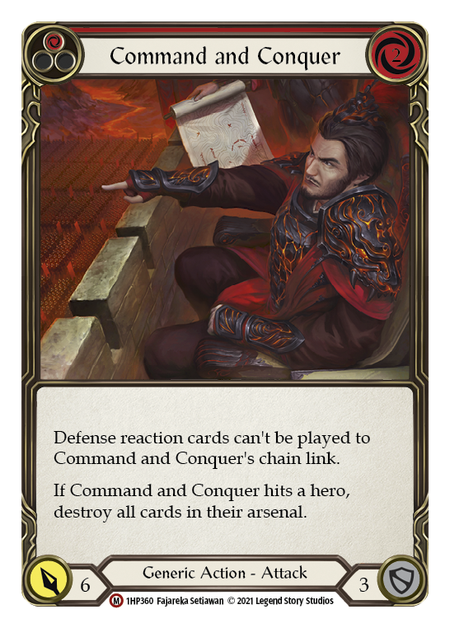
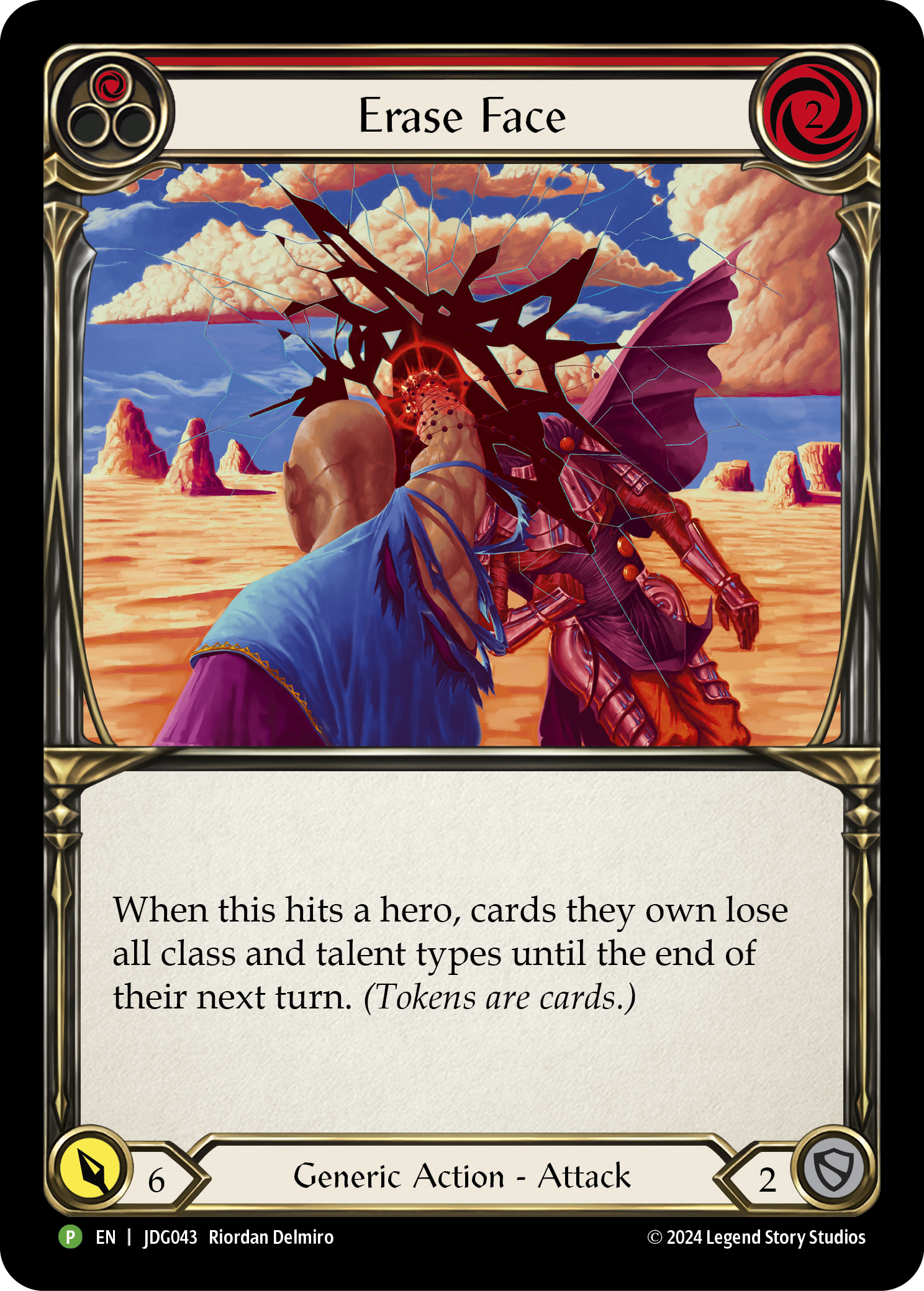
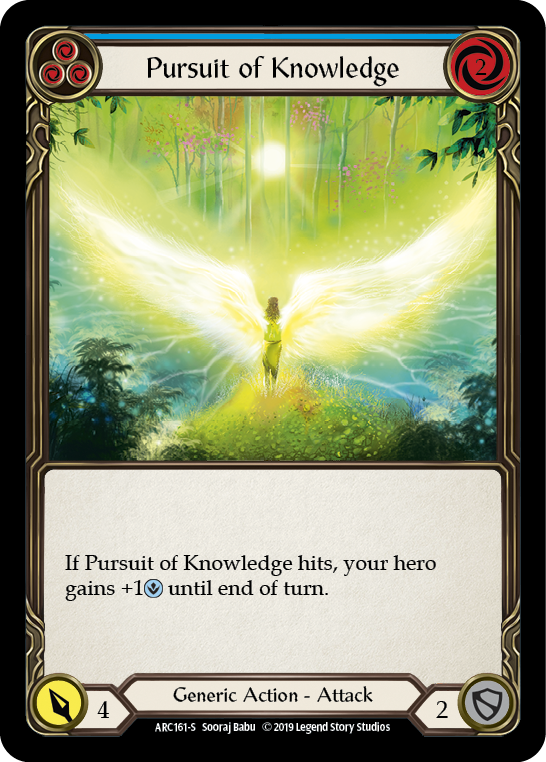
Another strength of Uzuri's ability is the fact that generic attacks are fair game as long as they cost 2 or less. With a bunch of new 2-cost attacks with on-hit effects in the set, we're spoiled for choice.
No Room for Reactions?
The attack reactions are where it all comes together (or falls apart, depending on who you ask). Uzuri has access to many powerful attack reactions, but they don't always play nicely with one another.



Shred is an Arakni staple, and will probably be an Uzuri staple as well, but it's not a good card if opponents aren't interested in blocking, like a lot of aggressive decks. Pummel is phenomenal with many of our 2-cost payoff cards like Shake Down and Command and Conquer, but it can only work with those payoff cards which can leave you with some very awkward hands. Razor Reflex looks great on paper with all the stealth attacks and Death Touch, but it doesn't work with your bigger payoff cards.
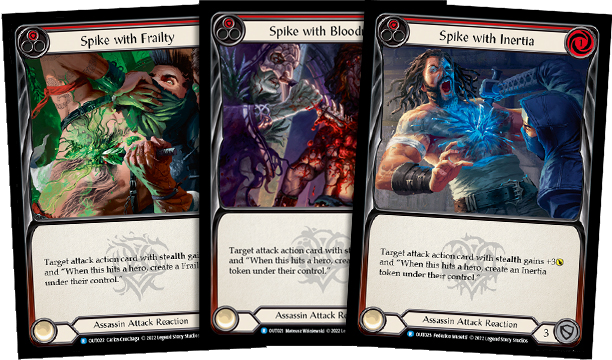
The Spike cycle is awesome, but again we have a bunch of reactions that only work with a subset of our deck, and it's the subset that is distinctly not our payoff cards. Without a way to give our attacks stealth, these will likely have limited constructed application.
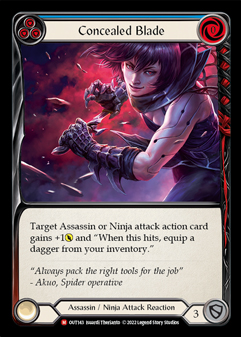
Concealed Blade is the best general attack reaction we have access to, but again we've got restrictions, as it can only target our Assassin attack actions. It will still see play as a 3-block Lunging Press, particularly since it's also the only way to equip daggers from your inventory. Razor's Edge is a nice boon for stealth strategies. Surprise damage that doesn't require resources is generally strong.
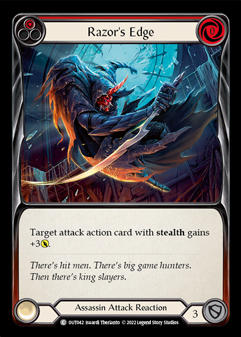
Tools of the Trade
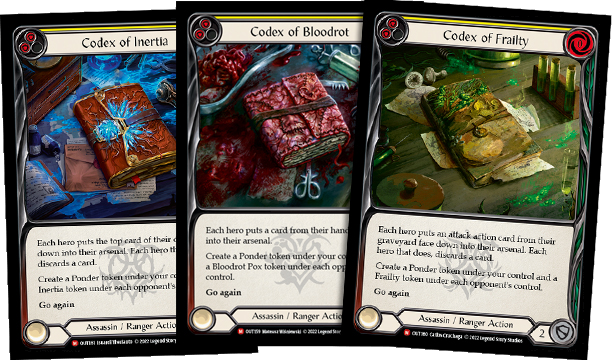
The entire codex cycle is very strong, but I suspect Codex of Frailty will prove itself the best of the trio. Selecting a specific attack action out of your graveyard is very powerful card selection, and the downside of discarding a card can be avoided entirely if your hand is already empty. If you're scrapping for tempo in a game, you can block with 3 cards, play Codex of Frailty putting a Death Touch into arsenal, and use a Tunic resource to play the Death Touch. That's a one card hand that threatens 6 damage and a Bloodrot or Inertia token, plus gives you a Ponder and your opponent a Frailty. All aboard! The value train is leaving the station.
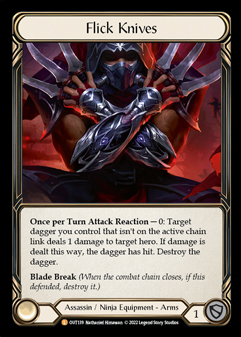
Flick Knives is where Assassin starts to get very tricky. Its ability is a reaction, which means cards like Shake Down and Sneak Attack appreciate it being activated. Since damaging an opponent with Flick Knives counts as a hit for the destroyed dagger, that means we can use our toolbox of daggers to deliver a devastating debuff to our opponent's defenses in a crucial moment. Flick Knives can allow you to double dip on debuffs too, since you can flick a dagger as long as it isn't on the active chain link.
The last thing Flick Knives does is effectively lower your opponent's starting life total, similarly to Mark of Lightning. There are very few ways to prevent the point of damage that Flick Knives threatens to do, so the difference between being at 1 and 2 life is massive (much like with Steelblade Shunt or Reckless Swing).
The downside of throwing away a weapon is not to be underestimated though, as currently only Concealed Blade allows us to re-equip a free hand.
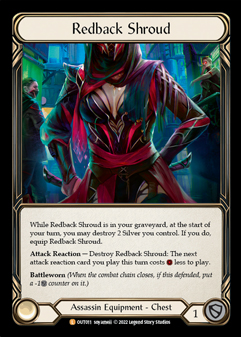
The age-old question of, "Do I run Tunic or my flavorful class chest equipment?" has an all-too-familiar answer for Uzuri. Redback Shroud is an amazing design, but with Uzuri not generating silver, Tunic generates much more value over the course of a long game. Shroud might be the correct call in Blitz, but without some new cards that bridge the gap between stealth and contract, Shroud joins the long line of chest equipment that just can't compete with Tunic.
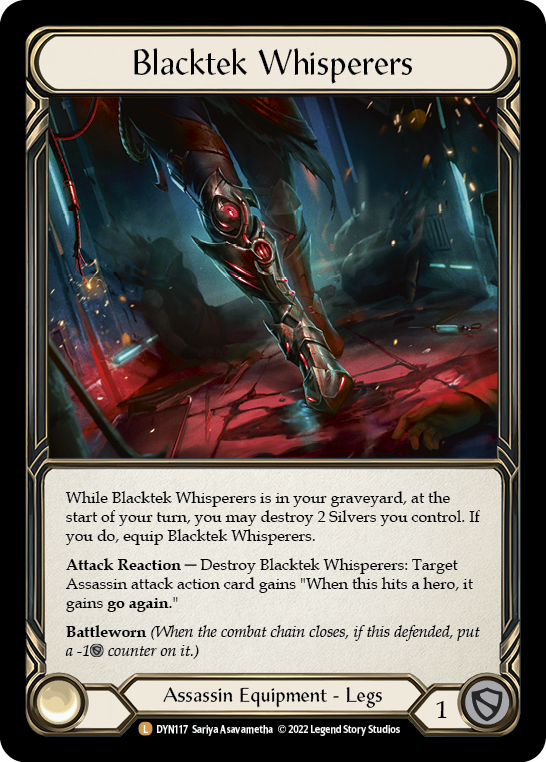
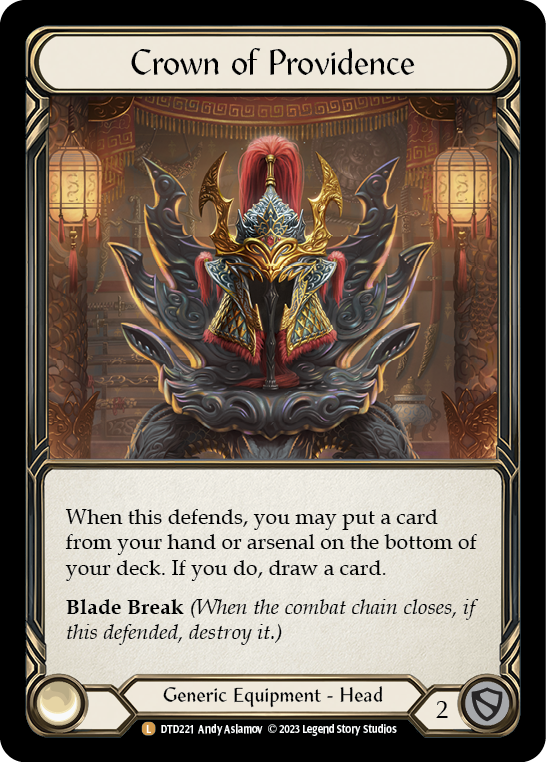
Crown of Providence and Blacktek Whisperers rounds out our equipment loadout. Crown needs no explanation at this point, and Blacktek Whisperers is the one piece of equipment we'll run that can be rebought with silver. Mask of Perdition's ability doesn't do much for Uzuri, so we'll leave that to Arakni. Snapdragon Scalers are an excellent budget alternative since we're not going to be able to re-buy Blacktek Whisperers in most games anyways.
The Uzuri Core
It's still very early in testing and prep for the Pro Tour, so I don't have an 80-card list ready to share that I'd feel confident about taking to a real event; but for anyone looking for a place to start, here are what I'd consider core cards for a CC Uzuri deck:
Weapons:
-Spider's Bite x2
-Orbitoclast x2
-Scale Peeler x1
Equipment:
-Flick Knives
-Crown of Providence
-Fyendal's Spring Tunic
-Blacktek Whisperers
- Shake Down x3
- Death Touch red x3
- Infiltrate x3
- Isolate x9
- Shred blue x3
- Concealed Blade x3
- Surgical Extraction x3
- Leave No Witnesses x3
- Command and Conquer x3
- Spreading Plague x3
Beyond this core of cards, you need to choose from a few directions. You could lean into the 2-cost payoffs and add Pummels to the mix; go heavier on the stealth synergies and run Back Stab, the Spike reactions, and Razor's Edge; or lean more on Death Touch and run Razor Reflex to keep your opponents on their toes while you swing wide.
Uzuri is crazy fun, but is going to be a tough nut to crack. Much like Runeblades, she requires a delicate balance of different card types in order to function - except instead of two types (attacks and non-attacks) she needs three (stealth cards, payoff cards, and attack reactions). You need a critical mass of stealth cards to ensure that you can consistently take advantage of her ability, but if your opponent can weather the offense of your first cycle, how do we convert second cycle hands full of 0-for-3 stealth cards into a victory? These are the questions my team is trying to answer as we ramp up our testing for the PT, and I promise you if I figure it out in the next two weeks, I'll be playing Uzuri at the MinMax Brawl 5k in Chicago.


